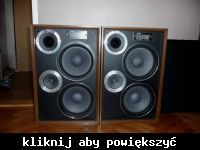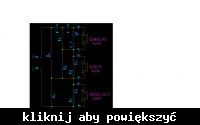398216 Usunięty wrote: Each loudspeaker, whether produced ten years ago or today, has an efficiency of several percent. Writing in this way what a colleague is misleading, implying that the difference is significant. The percentage is small - because it is only a few% of the difference.
These few percent, however, make a big difference when the loudspeaker's efficiency, as you admitted above, is also measured in single percentages. In the mid-1970s, the 16cm speaker had 15W - and efficiency of over 90dB, today, and several dozen watts at this size, it does not shock, but also does not cause embarrassment, the efficiency of 85dB or even less.
Quote: The difference in loudness is due to the fact that a loudspeaker with a larger diameter does not have to tilt so much from its rest position to generate a similar sound pressure than a loudspeaker with a smaller diameter.
And a large deflection causes, among others the necessity to use a long coil, only a small part of which fits into the slot of the magnetic core, and only it drives the diaphragm. The rest of the coil is just a resistor in which the power supplied to the loudspeaker is lost. Hence the degradation in efficiency when trying to get high power from a small diaphragm.
Quote: The passive diaphragm works on the same principle as the BR - it resonates by emitting a sound in this range (not strictly the resonant frequency, of course, but - just like the BR in a certain range above and below this frequency).
The main difference is that, unlike the opening, the passive membrane has a certain, significant compliance (in other words, it is very soft, e.g. due to the lack of a lower spring), but its mass is greater than the acoustic mass of the opening with a tunnel with even the largest real depth and the same diameter. Thanks to this, it is possible to obtain a sufficiently low natural frequency of the MB housing, with a diaphragm size that would not be provided by any hole. And the larger the diameter (of the passive membrane or the opening), the greater its impact on the sound of the loudspeaker.
Quote: Therefore, the phenomenon of resonance is used - the interaction of the rear side of the woofer diaphragm causes the passive diaphragm to resonate. If you understood literally what a colleague wrote, you could conclude that this is not the case, and the MB is only set in motion by changing the pressure inside the housing - it is,
My point is that w and BR, and in MB, the energy lost in enclosures enclosed in a damping material is used.
Quote: but below the resonant frequency of the woofer and (as in the BR) it does not increase the amount of radiation through the bass column - quite the opposite. Below the resonance frequency you can see (in the efficiency graph) and hear a clear decrease in the bass radiation, as both waves (speaker and MB) subtract.
Granted, but also nowhere have I claimed that thanks to a hole or a diaphragm, it is possible to effectively radiate power in the range below the resonance, even though the speaker diaphragm in these conditions
rages. Quote: I advise against such a combination. As everyone knows, the GDS30 / 30 plays in the medium and high range (especially) very "aggressive / hard".
I bought these speakers back in the early 90's and they have been useless since then. I'm just curious what you can do with them. After all, I already have boxes, it remains to add to them interchangeable front panels with a set of speakers, a crossover and a BR tunnel. It's known that
Versailles it will not (I have already measured how hopelessly high QTS have; this is definitely different than, for example, GD25 / 40/3 used in "Altus", also highly specific)
Quote: After adding GDWT, this phenomenon will only get worse. Unless you want to cut these frequencies with a crossover - then the GDS will sound comparable to the GD,
The cut must be: if only because I would not like the impedance of the band to drop to half for high frequencies, when GDWT is turned on (GD, unlike GDN, have a short coil with a low parasitic inductance and turning them on would have such an effect). The only question is how high this cut will be.
Quote: but in turn GDWT will not be able to release enough power to compensate for the decrease in this range (medium and high - especially medium) frequencies. So an additional mid-tone speaker would be needed - similar to the Author's ZG40c,
Here (due to the features of the main speaker) it would be more appropriate to compare it with the ZGP series units, where the GD16 / 20, GD20 / 10 or GD20 / 20 were cast in this role, and the larger of the two GDW plays the role of the "midrange". I find it heavy
triumph of form over content so at this stage I reject the insertion of the additional say GD12 / 5. I will listen to what will come out on two speakers (GDS and GDWT), and then maybe I will consider this possibility.
Quote: Without it, you will either burn the GDWT speaker with too much power, or there will be a hole in the characteristics.
I'll try not to burn GDWT. Even if we consider that with the 12dB / oct filter it should have the old designation (GDWT9 / 40 and not GDWT9 / 80), the power of the unit will not exceed 30W (that's how much GDS has) So it should withstand cutting at 4kHz, at least that's what the manufacturer declares. So the GDS will have to be used for this frequency, and what will come out of it - I will see for myself.
Quote: The medium frequencies emitted by the GDS are extremely unpleasant for the ear, so cutting higher (above the medium frequencies) will make this range (and, as you know, especially important for music and the most critical for hearing), "flashy" - too "sharp".
And it will have to be that way. And when it turns out to be so unpleasant for me - I will always be able to sell almost unused speakers to somebody
szarpidrutowi ; probably right away
castrate use a razor blade from a tweeter funnel to make them sound less unnatural.

Quote: It is true that "stage" loudspeakers were made on these speakers, but anyone who heard them knows how they sound ...
Of course I would definitely prefer the GD30 / 15 (despite being twice as powerful); if you believe Witort, they were very much appreciated at that time. But at the turn of the political system, you bought
with a kiss of the hand what happened. Quite recently, I bought u
Florek on
volume a couple of dream GD30 / 15 but I was disappointed right after unpacking them. The marking was the same as above, but the diaphragm was there
as hard as breath in this respect, they did not differ in anything from the previously purchased (but in the store) GDS30 / 30. The design of the diaphragm itself was also apparently identical in both cases, except of course the lack of a funnel in the GD30 / 15. The free resonance frequency was also very similar (in both cases - close to 70Hz, as much as the GD30 / 30 should have without "S" in the designation), while the GD30 / 15 (not being a GDN!) Should boast a fr equal to 50Hz. Now I have a suspicion bordering on the certainty that
Florkowi two burnt or torn GD30 / 15 fell into his hands, so he "regenerated" them by inserting what was available now, i.e. vibrating systems from typical
gitarowców GD30 / 30 or GD30 / 50, and the markings on the magnet yoke did not change, because what for? Of course, I will be able to try these speakers in place of the GDS30 / 30, but (regardless of the fact that in this situation it is difficult to expect better results compared to the GDS30 / 30) it would be
pain in the butt as the alleged GD30 / 15 have 15 ohms instead of 8 ohms and in this case the existing GDWT would have to be switched on via a 6.8 ohm series resistor or the autotransformer in place of the coil in the jumper.
Quote: There were also loudspeakers where an additional GDWT was added via a simple crossover, but it was cut very high - it only "made up" for the loss of GDS efficiency in the range above 6-8 kHz.
Here, a high cut resulted from the fact that one GDWT had to handle two GDSs. This variant is not an option for me for an obvious reason: I do not have a second pair of GDS, and at least I would like to squeeze both GDS30 / 30 and the alleged GD30 / 15 into one team (assuming that it is indeed GD30 / 15 that is evenpower, they will then be optimally used, creating a unit with a power of 45W and impedance close to 5?

There would be no room for it in our boxes anyway, due to the stiffening rungs to which the front walls are screwed.
Quote: Both without and with GDWT, these loudspeakers sounded similarly bad / unpleasant; the only difference is a bit more high frequencies
It will be as it will be. I am not going to buy one more pair of speakers (even 12 "Ticoons). Earlier I was tempted by a slightly smaller 10-inch size (tempted
szmacianym although with a relatively hard suspension) and I have also managed to convince myself that their QTS is similarly unfavorably high as in the case of the GDS30 / 30. It will probably be the same in the case of larger speakers from the same company, although I may be wrong. I also have a pair of 8-ohm speakers on
szmacianym suspensions bearing the designation GDN25 / 40/3 (i.e. those used in smaller and medium-sized "Altuses") and I could use them in BR sets by choosing a set of e.g. GD12 / 5-8? and any modern domes, but these GDNs ( purchased before I managed to buy the NOS GDN25 / 40-4?

have membranes
zapaprane it has some acrylic in black (at least the seller said) and their parameters may differ significantly from the catalog ones. So let me start with what raises the slightest suspicion, i.e. the NOS GDS30 / 30.





